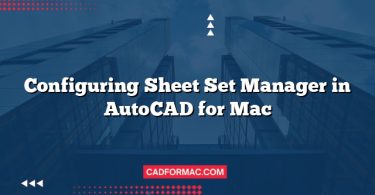AutoCAD for Mac offers powerful customization options that can significantly boost your productivity—especially when you tailor keyboard shortcuts to match your workflow. While the Mac version of AutoCAD differs slightly from its Windows counterpart in terms of interface and file structure, creating custom keyboard shortcuts is both possible and straightforward once you know where to look.
This guide will walk you through two primary methods for customizing keyboard shortcuts in AutoCAD for Mac: using the built-in Customize User Interface (CUI) editor and manually editing the PGP file (which defines command aliases).
Method 1: Using the Customize User Interface (CUI) Editor
The CUI editor is AutoCAD’s visual interface for managing commands, toolbars, menus, and keyboard shortcuts.
Step 1: Open the CUI Editor
- Launch AutoCAD for Mac.
- Go to the top menu bar and select Tools > Customize > Interface…
(Note: In some versions, this may appear as Tools > Customize User Interface.) - The Customize User Interface dialog box will open.
Step 2: Navigate to Keyboard Shortcuts
- In the left pane of the CUI editor, expand Keyboard Shortcuts.
- You’ll see categories like Default, User, and possibly others depending on your setup.
Step 3: Create a New Keyboard Shortcut
- Right-click on User (or the appropriate category) and choose New Keyboard Shortcut.
- In the right pane, a new shortcut entry appears. Click on it to select it.
- In the Properties panel (usually on the right side), configure the following:
- Name: Give your shortcut a descriptive name (e.g., “My Line Shortcut”).
- Macro: Enter the command you want to run (e.g.,
_line). - Key(s): Click in the Key(s) field and press the key combination you want to assign (e.g., Cmd+Shift+L).
Important: AutoCAD for Mac uses Cmd instead of Ctrl for many shortcuts. Be mindful of macOS system shortcuts that may conflict (e.g., Cmd+Q quits the app).
Step 4: Save and Apply
- Click Apply or OK to save your changes.
- Close the CUI editor.
- Your new shortcut is now active! Test it in your drawing.
Method 2: Editing the PGP File (Command Aliases)
AutoCAD uses a file called acad.pgp (Program Parameters file) to store command aliases—short text strings that trigger full commands (e.g., typing L runs the LINE command). You can add your own aliases here, which function like keyboard shortcuts when typed in the command line.
Step 1: Locate the PGP File
- In AutoCAD for Mac, go to AutoCAD > Preferences > Files.
- Under Support File Search Path, look for a path ending in Support.
- Navigate to that folder in Finder. The default location is usually:
~/Library/Application Support/Autodesk/AutoCAD 20XX/Rxx.x/enu/Support/(Replace “20XX” and “Rxx.x” with your version number.)
Step 2: Edit the acad.pgp File
- Make a backup copy of acad.pgp before editing.
- Open acad.pgp in a plain-text editor (like TextEdit in plain-text mode or VS Code).
- Scroll to the bottom of the file or find the section labeled User Defined Command Aliases.
- Add your custom alias using the format:
alias, *commandFor example:
myc, *circle drw, *draworder - Save the file.
Step 3: Reload the PGP File in AutoCAD
- Back in AutoCAD, type REINIT in the command line and press Enter.
- In the Re-initialization dialog, check PGP File and click OK.
- Your new aliases are now active. Type
mycand press Enter to draw a circle!
Tips for Effective Shortcut Customization
- Avoid Conflicts: Don’t override essential macOS shortcuts (e.g., Cmd+C, Cmd+V) or default AutoCAD commands unless intentional.
- Use Consistent Patterns: If you use
Cmd+Shift+Lfor Line, considerCmd+Shift+Cfor Circle to maintain logic. - Document Your Shortcuts: Keep a personal cheat sheet of your custom shortcuts for quick reference.
- Test Thoroughly: Always test new shortcuts in a blank drawing to ensure they work as expected.
Troubleshooting
- Shortcut Not Working?
Check for conflicts in the CUI editor or ensure you’re not overriding a system-level macOS shortcut. - PGP Changes Not Taking Effect?
Confirm you’ve run the REINIT command and selected PGP File. Also, verify you edited the correct acad.pgp file in the support folder. - CUI Option Missing?
Ensure you’re using a recent version of AutoCAD for Mac (2018 or later). Older versions may have limited customization options.
FAQ: Custom Keyboard Shortcuts in AutoCAD for Mac
Below are frequently asked questions about creating and managing custom keyboard shortcuts in AutoCAD for Mac—covering topics not addressed in the main article.
Q1: Can I import or export my custom keyboard shortcuts to use on another Mac or share with a colleague?
A: Yes! Your customizations made via the CUI editor are saved in a .cuix file (typically named AutoCAD.cuix or user.cuix). You can find it in:
~/Library/Application Support/Autodesk/AutoCAD 20XX/Rxx.x/enu/Support/
To share, simply copy this file to the same location on another Mac (after backing up their original file). Then restart AutoCAD or reload the CUI via Tools > Customize > Interface….
Q2: Why can’t I assign a shortcut that uses the Function keys (F1–F12)?
A: On many Mac keyboards, Function keys are reserved for system controls (like brightness or volume) by default. To use F1–F12 as standard function keys in AutoCAD:
- Go to System Settings > Keyboard.
- Check “Use F1, F2, etc. keys as standard function keys”.
After this, you can assign shortcuts like F5 or Cmd+F9 in the CUI editor without interference.
Q3: Do custom shortcuts work in all AutoCAD workspaces (2D Drafting, 3D Modeling, etc.)?
A: Yes—keyboard shortcuts defined in the CUI editor or PGP file are global and apply across all workspaces unless specifically restricted (which is rare in the Mac version). However, some commands may behave differently depending on the active workspace or drawing context.
Q4: Is it possible to disable or remove a default AutoCAD shortcut?
A: You cannot delete built-in shortcuts, but you can override them. In the CUI editor, assign a new command (or a blank macro) to the same key combination. This effectively replaces the original behavior. For PGP aliases, redefining an alias (e.g., changing L, *LINE to L, *MYCUSTOMCOMMAND) will override the default.
Q5: Can I use non-English keyboard layouts (e.g., French AZERTY or German QWERTZ) with custom shortcuts?
A: Yes, but be cautious. AutoCAD for Mac interprets shortcuts based on the physical key position, not the character printed on the key. If you switch keyboard layouts frequently, your shortcuts may not behave as expected. It’s best to define shortcuts using keys that remain consistent across layouts (e.g., letters rather than symbols like ; or ').
Q6: What’s the difference between a CUI keyboard shortcut and a PGP alias?
A: A CUI shortcut is a true keyboard combination (e.g., Cmd+Shift+L) that triggers a command instantly. A PGP alias is a text abbreviation (e.g., typing C for CIRCLE) that you enter in the command line. Use CUI shortcuts for quick actions without typing, and PGP aliases to speed up command-line input.
Q7: Will my custom shortcuts be lost after an AutoCAD update?
A: Generally, no—AutoCAD preserves user customization files (like user.cuix and your modified acad.pgp) during updates. However, it’s always wise to back up these files before installing a major update, just in case.
Q8: Can I assign a shortcut to a LISP routine or script?
A: Yes! In the CUI editor, when creating a new keyboard shortcut, set the Macro field to run your LISP file. For example:
^C^C(load "myroutine") (myfunction)
Or for a script:
^C^C_script; "myscript.scr"
Make sure the LISP or script file is in a support path recognized by AutoCAD.
Q9: Why does AutoCAD sometimes ignore my custom shortcut and perform a macOS system action instead?
A: macOS reserves certain key combinations (e.g., Cmd+Space for Spotlight, Cmd+Tab for app switching). AutoCAD cannot override these. Always test your shortcuts and avoid combinations used by macOS or other active applications.
Q10: Is there a list of all default AutoCAD for Mac keyboard shortcuts?
A: Yes. Go to Help > Keyboard Shortcuts in AutoCAD for Mac to open the official shortcuts reference. You can also find a printable PDF in the AutoCAD Help documentation online under “Keyboard Shortcuts (Mac).”
Conclusion
Custom keyboard shortcuts in AutoCAD for Mac empower you to work faster and reduce repetitive tasks. Whether you prefer the visual approach of the CUI editor or the direct control of editing the PGP file, both methods offer flexibility to tailor AutoCAD to your unique design process.
Take time to identify the commands you use most often, then assign intuitive shortcuts that fit naturally into your workflow. With a little setup, you’ll shave seconds off every task—adding up to significant time savings over the course of a project.




